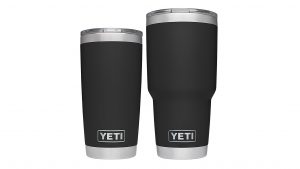Q: Hello, I wanted to ask about my Yeti. I usually take it to the office in the morning for my coffee because it keeps it warm for a few hours. It holds a lot of liquid and sometimes I get busy during the day and don’t have time to drink it all before it gets cool. Can you microwave a Yeti? It is not made of aluminum but I wasn’t sure if the metal will be safe to put in the microwave, I heard that travel mugs may be OK to heat if you are in a hurry.

Can You Microwave a Yeti?
A: First, let’s start by explaining what a Yeti cup is and is made from. The Yeti Rambler is a vacuum sealed insulated tumbler made of stainless steel with a plastic lid. Putting any type of metal in the microwave is cautioned against. We all know aluminum foil is dangerous but this applies to stainless steel as well. The science behind the microwave involves converting electrical energy to radio waves. Many people believe that the waves themselves carry the heat to heat up whatever is in the microwave, but it is actually the vibrations of the waves that generate heat. Metal (including stainless steel) reflects the waves which are what make it dangerous. When the waves are reflected, this causes the vibrations to be far too fast generating too much heat. The metal object (in this case the Yeti) would not melt while being microwaved because the molecules are too close in it to be affected, but metals like steel and tin will catch your microwave on fire due to the high frequencies.
Since the Yeti Rambler has an irregular shape, it has a higher chance of reflecting the waves, thus creating more danger of starting a fire due to the high amount of vibrations in your microwave. Leaving the plastic lid on the Yeti would also cause it to melt due to the intense heat inside. Additionally, since the Yeti is so insulated and the metal does not get affected by the waves, the liquid inside would largely remain unaffected. Some travel mugs are OK to put in the microwave, but none made of metal. If you have other mugs that you are unsure about, they will usually say on the bottom whether they are microwave safe or not.
There are better options for heating up your morning coffee than sticking your Yeti inside of a microwave. Additionally, it has been found that after coffee cools down, the rich aromas also break down with it. Reheating your coffee in the microwave will cause the few remaining aromas to further break down resulting in your coffee tasting old and bland. It is recommended by coffee experts to simply brew another pot or make another run to your favorite cafe. The breakdown of the flavor profile will ruin your cup O’ Joe. If you are really in a time bind, putting it on the stovetop in a pan will be your best choice.
So in short, can you microwave a Yeti? The answer is NO, it will be very unsafe to do so. These Yeti products are designed to keep the heat in, not to reheat. Make sure you keep your lid on your Yeti at all times so it can work to its best ability to keep your liquid hot or cold. Those who have independently tested the Yeti have said that optimal conditions give them about 5 hours of heat for their drinks. This should give you a good window of enjoyment and if the liquid does need to be reheated, please use another container to do so unless you want to deal with dangerous fire.
I suspect a magnetic induction cooktop might work to heat up cold coffee in a Yeti.
Your understanding of RF energy is poor, this so is your explanation. Microwave ovens are simply radio transmitters in a metal box. The frequency of 2.45 MHz was discovered to move the molecules of water more than any other frequency. The waves do not vibrate. They oscillate. The oscillation does not change frequencies and speed up just because they are reflected. I won’t bother explaining inductive coupling, but 2.45 MHz is no more likely to catch fire than any other frequency. The yeti will not give up its extra electrons to arc like aluminum foil but it’s still dangerous to the magnetron tube of the microwave because the waves are reflected back into the transmitting tube causing overheating and eventually failure of a very expensive component. KK4SG Amateur Extra